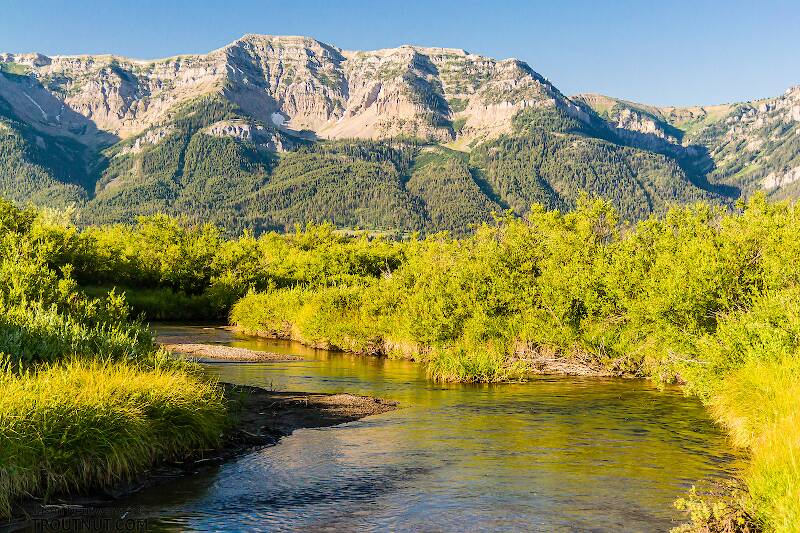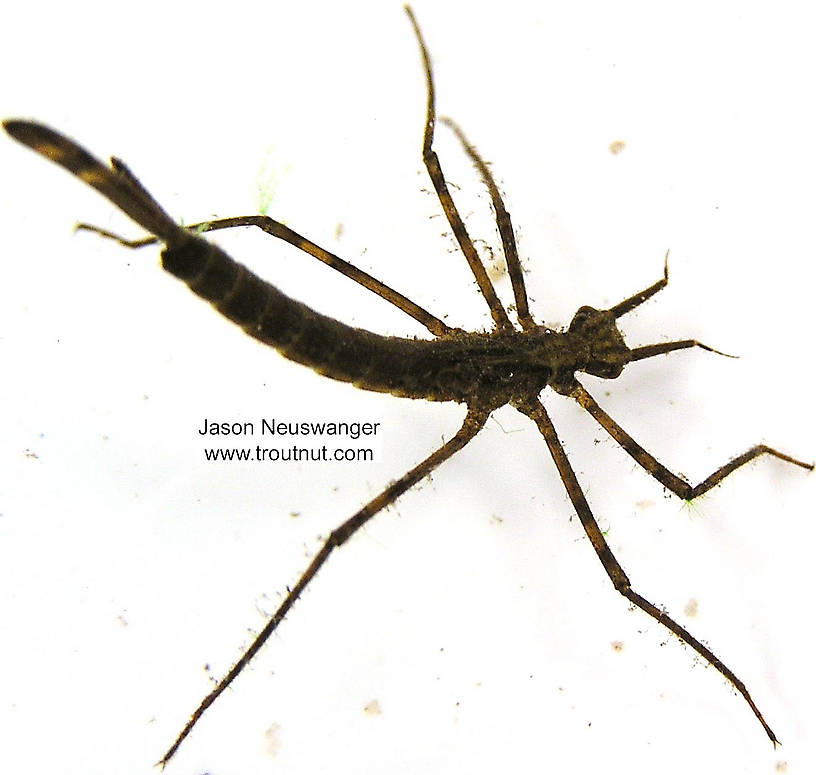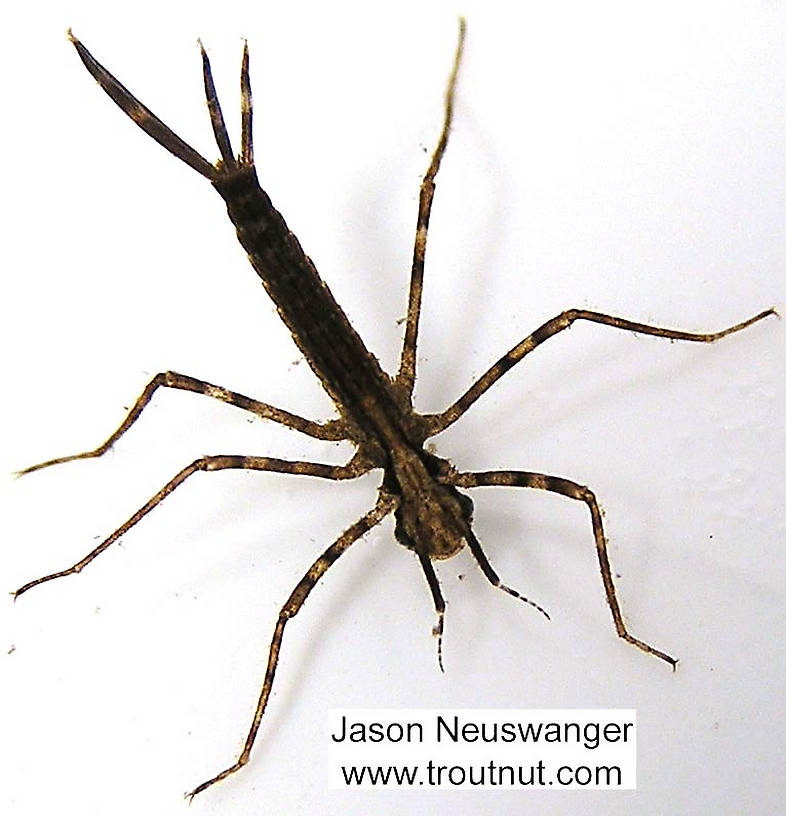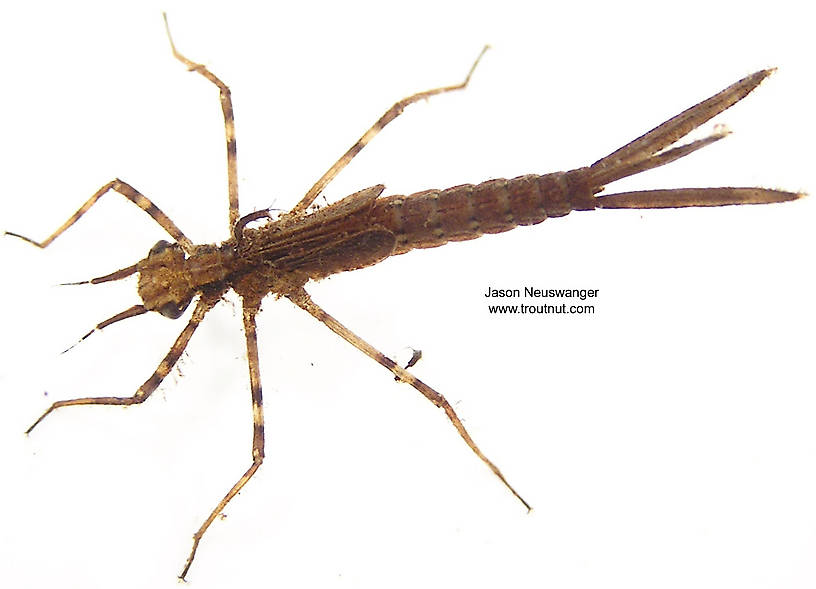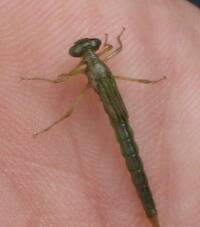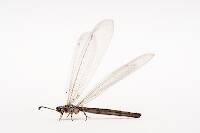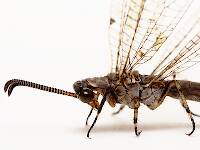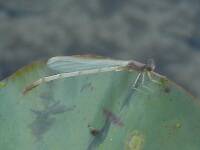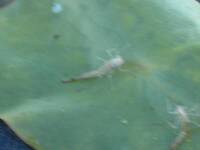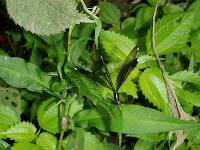
Salmonflies
Pteronarcys californica
The giant Salmonflies of the Western mountains are legendary for their proclivity to elicit consistent dry-fly action and ferocious strikes.
Featured on the forum

Troutnut is a project started in 2003 by salmonid ecologist Jason "Troutnut" Neuswanger to help anglers and
fly tyers unabashedly embrace the entomological side of the sport. Learn more about Troutnut or
support the project for an enhanced experience here.
This topic is about the Insect Order Odonata-Zygoptera
Beautiful damselflies are a priceless part of a trout stream's aesthetics, but they matter little to our flyboxes. The adults are too good at flying to end up in the water where the trout can reach them very often, but their nymphs are welcome prey at times.Damselflies and dragonflies are in the same order, Odonata, but they are taxonomically separated on an obscure level not built into this site, the suborder. Damselflies are in the suborder Zygoptera, the scientific name by which they're most known. None of that will help you catch trout, but it explains what the hyphen in this page's title is all about.
Biologically, damselflies are similar to dragonflies (Odonata-Anisoptera) in most of the ways that matter to the angler.
Example specimens
WildcatRob on Dec 9, 2007December 9th, 2007, 3:28 am EST
While Damselflies are not of great interest to the stream fisher, they are of great interest to the lake fisher.
Creatures of shallow, non fluctuating, weed filled trout lakes, Damsel nymphs migrate in mass to shore for their final molt. As the reach shore the climb out on emergent foliage, lock their claws into and wait while the exoskelton splits to reveal the most graceful of acquatic insects (I'm ducking the brickbats.)
The migration is relatively slow and close to surface with zigzags and pauses.
Mature damsels fold their wings parallel to the body, while hatched dragons hold their wings perpendicular to the body. Mature Damsels are of little interest to trout.
A damsel hatch will put all the really big trout in a lake in motion. These hogs like to get right up against the emergent vegetation picking the nymphs off as they start to climb out.
Anyone who has fished a damsel emergence will never forget the experience. Having experienced one, I am most fortunate. Because you would count me amongst the great liars of our sport, I won't tell the whole story.. The brief facts are: In less than 90 minutes 3 cutthroat - 7+ pounds total, one lost and one over 6 pounds scared away. The lake is Lenice. It's public. It's reknown for huge cutthroat. It's a challenge.
For a compact Odonta/damsel reference, I recommend 'The Gilly' A Flyfisher's Guide, Edited by Alfred G. Davy 1985 IBSN 0-88925-638-1 pp 69-74 as one of many compact references.
WildcatRob
Creatures of shallow, non fluctuating, weed filled trout lakes, Damsel nymphs migrate in mass to shore for their final molt. As the reach shore the climb out on emergent foliage, lock their claws into and wait while the exoskelton splits to reveal the most graceful of acquatic insects (I'm ducking the brickbats.)
The migration is relatively slow and close to surface with zigzags and pauses.
Mature damsels fold their wings parallel to the body, while hatched dragons hold their wings perpendicular to the body. Mature Damsels are of little interest to trout.
A damsel hatch will put all the really big trout in a lake in motion. These hogs like to get right up against the emergent vegetation picking the nymphs off as they start to climb out.
Anyone who has fished a damsel emergence will never forget the experience. Having experienced one, I am most fortunate. Because you would count me amongst the great liars of our sport, I won't tell the whole story.. The brief facts are: In less than 90 minutes 3 cutthroat - 7+ pounds total, one lost and one over 6 pounds scared away. The lake is Lenice. It's public. It's reknown for huge cutthroat. It's a challenge.
For a compact Odonta/damsel reference, I recommend 'The Gilly' A Flyfisher's Guide, Edited by Alfred G. Davy 1985 IBSN 0-88925-638-1 pp 69-74 as one of many compact references.
WildcatRob
Taxon on Dec 9, 2007December 9th, 2007, 7:48 am EST
Rob-
Your information on damselflies is both accurate and interestingly presented. With regard to Lake Lenice, I believe it to be planted with rainbows, browns, and even tiger trout (a brown/brookie cross), but not cutthroat.
However, this may all become a moot point, as there are plans to build a dam on Crab Creek, forming a huge reservoir running from just east of Beverly, upstream nearly to the dam forming Potholes Reservoir. This would bury the Nunnelly/Lenice/Merry chain of lakes beneath several hundred feet of water, which is certainly an ugly prospect.
Your information on damselflies is both accurate and interestingly presented. With regard to Lake Lenice, I believe it to be planted with rainbows, browns, and even tiger trout (a brown/brookie cross), but not cutthroat.
However, this may all become a moot point, as there are plans to build a dam on Crab Creek, forming a huge reservoir running from just east of Beverly, upstream nearly to the dam forming Potholes Reservoir. This would bury the Nunnelly/Lenice/Merry chain of lakes beneath several hundred feet of water, which is certainly an ugly prospect.
Taxon on Mar 6, 2008March 6th, 2008, 1:41 pm EST
As an update to my earlier post, just heard from someone who knows, the proposed Crab Creek Dam is no longer under consideration. Good news, that!
Sayfu
Posts: 560
Posts: 560
Sayfu on Aug 29, 2011August 29th, 2011, 6:34 am EDT
In my experience with damsels, the nymph migration at, or near the start of the Summer season is a happening. Very exciting, and rewarding to the angler that fishes a damsel pattern, and fishes it in the right way. But nothing is more exciting than fishing the adult damsels when they are mating, and being taken on the surface. The takes are violent, much like a large mouth bass attacking a popper pattern. Break offs on the take, or when the trout dives for the weed beds can be frequent, and heart stopping.
Quick Reply
Related Discussions
Topic
Replies
Last Reply
1
Jul 1, 2008
by GONZO
by GONZO
6
Nov 4, 2011
by Dinerobyn
by Dinerobyn
1
Jul 11, 2008
by Taxon
by Taxon
2
Apr 25, 2016
by Afishinado
by Afishinado

